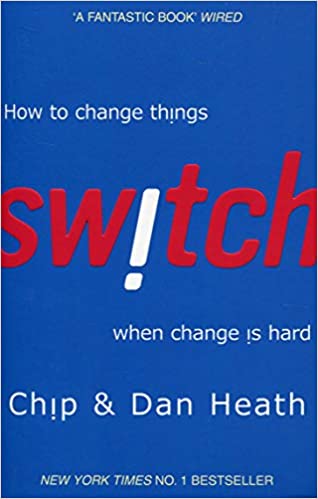Switch: How to change things, when change is hard
Switch: How to change things, when change is hard, is a book about change management. Generally, my interest is consumer psychology that provides a much better and deeper understanding of the typical marketing consumer behavior that is not available in any textbook. I have read another bestseller Made to Stick by Chip Heath and Dan Heath, the two brothers who have co-authored the Switch as well.
Made to Stick was about how to make ideas contagious and deals with why some ideas (communication) stick with consumers with a set of excellent examples and a guiding framework. The book was quite good and hence, i thought of giving Switch a try.
The disclaimer first: Switch is not a specific marketing or consumer behavior book. It is about CHANGE MANAGEMENT, which deals with any kind of changes from organization to individual behavior (one example in the book deals with changing milk consumption habits of US consumers). This is similar to the Power of Habit book by Charles Duhigg.
The Heath brothers suggest the basic three-part framework needed to implement any change:
1. Direct the Rider:
Provide crystal clear directions to the rational part of a human nature. The rational part of the brain is the one that deliberates, analyzes and looks into the future. It’s also called the reflective or conscious system. What often looks like resistance from the rational part is frequently just a lack of clarity. To direct the Rider, you have to find the bright spots in a situation and script critical moves of how you will get to the goal.
2. Motivate the Elephant:
The rational part demands a tremendous amount of self-control, which comes in limited resources. That’s why laziness often seems like exhaustion. The only way for a change to last is to have an emotional drive. That’s why people’s emotional side needs to be engaged and they must believe they are competent enough to make the change. The emotional part of human nature is the part that is instinctive and feels pain and pleasure.
3. Shape the Path:
What many times looks like a people problem is only a situation problem. The situation, including the surrounding environment, is called the Path. When you properly shape the Path or, in other words, tweak the environment, you make change more likely to happen.
The rider is basically the rational part of our brain which knows that eating pizza or burger is unhealthy.
The elephant is the emotional part which always looks for instant gratification and opposes the rider. There is always a fight between rider and elephant. Whether to order burger or not!
The path is the process or way to handle or rather reduce the conflict between rider and elephant.
So, lets understand the above in the context of milk consumption. The USA consumers consumed regular milk which has more than the required amount of saturated fat. So, the task at hand was to change the milk consumption behavior – replace the existing milk with 1% fat milk (skimmed milk). So, one way is to burn money on marketing communication about telling people how unhealthy or healthy both the options are? But we all know how healthy stuff works (McD Pizza Hut would be closed by now!). In fact, researchers found out that it is not about changing consumption behavior, but purchase behavior. If people buy skim milk, they will consume it. So, instead of going about pure healthy debate, they used innovative marketing. For example, they started comparison ads – a glass of milk has fat equal to found in five bacon. In local stores, they showed amount of fat in a tube that can be found in one gallon of milk. The display of real fat was disgusting least to say (like some Hollywood depiction of aliens). These tricks worked and gradually people preferences shifted toward skim milks. That’s how change management works! Idea is to identify bright spot which works and then build on it. May be one need to look for tiny clues first to understand the problem.
What looks like resistance is often a lack of clarity.
However, I personally find a striking similarity between the book and the mythology about how our desires work and how to control them? The fight among man, buddhi, and chitta (brain, senses, conscious, intellect).
चञ्चलं हि मनः कृष्ण प्रमाथि बलवद्दृढम्।
तस्याहं निग्रहं मन्ये वायोरिव सुदुष्करम्।।
स्पर्शान्कृत्वा बहिर्बाह्यांश्चक्षुश्चैवान्तरे भ्रुवो: |
प्राणापानौ समौ कृत्वा नासाभ्यन्तरचारिणौ ||
यतेन्द्रियमनोबुद्धिर्मुनिर्मोक्षपरायण: |
विगतेच्छाभयक्रोधो य: सदा मुक्त एव स: ||
